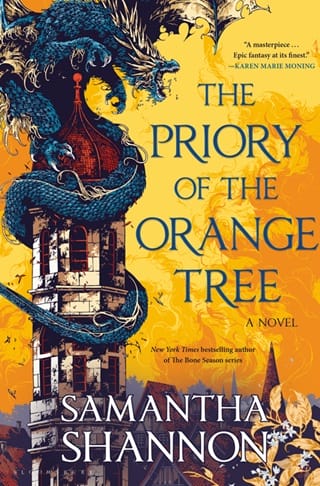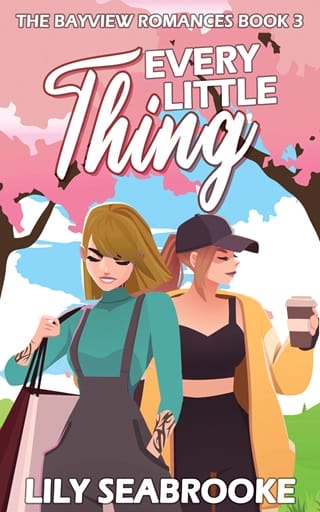Glossary
Attifet : A headdress worn by women in the northern provinces of Inys. It dips in the middle, lending it a heartlike shape.
Baldachin : An ornate canopy that stands over the boss of a sanctuary .
Barding : Horse armor.
Bodmin : A wildcat, known to roam the moors of Inys. Its fur is warm and, due to its rarity, expensive.
Boss : The raised center of a shield. In Inys, this name is given to the platform at the heart of a sanctuary , where the sanctarian preaches and ceremonies take place.
Buckler : A small shield.
Carcanet : A jeweled chain or necklace.
Charnel garden : A place where bones are buried, usually attached to a sanctuary .
Comfit : Fennel seeds coated in sugar.
Coney : A wild rabbit.
Creamgrail : An Inysh flower. The sap it produces is a valuable commodity—when combined with water, it forms a thick cream that cleans and scents the hair. When prepared correctly, its root induces sleep.
Cupshotten : Drunk.
Damsam : A mild Inysh oath. Contraction of “Damsel’s name.”
Dipsas : Venom from a tiny snake native to the Ersyr.
Doublet : A close-fitting jacket with long sleeves and a high collar.
Dowry : A transfer of money upon marriage.
Eachy : A sea cow.
Emmet : An ant.
Eria : A colossal salt desert beyond the Gate of Ungulus. No one living has ever been known to cross it.
Farthingale : A hoop skirt stiffened with whalebone, worn beneath Inysh and Yscali gowns to give them a distinctive bell-like shape.
Fesswise : Horizontally, in the manner of a heraldic fess.
Foxfire : Bioluminescence, caused by rotting fungi.
Fustian : A heavy cover for a bed, made of twilled cloth.
Garth : A small courtyard.
Girdle : A jeweled chain, worn around the hips as a belt.
Grievoushead : An Inysh term for depression or dejection of the spirits. It runs in the House of Berethnet.
Gurnet : A bottom-feeding sea fish. The word is used in Inys as an all-purpose insult.
Haithwood : A primeval forest in the north of Inys, which divides the provinces of the Leas and the Lakes. It is associated with the legend of the Lady of the Woods.
Halberd : A two-handed Seiikinese weapon with a broad, curved blade at one end.
Halgalant : The afterlife of the religion of the Virtues of Knighthood, said to have been built in the heavens by Sir Galian Berethnet after his demise. A beautiful castle in a bountiful land where King Galian holds court at the Great Table with the righteous.
Hellburner : A type of Mentish fireship that uses a clockwork mechanism to ignite a fuse, causing a massive explosion.
Herigaut : A garment worn by sanctarians in Inys, usually made of green and white cloth. Some believe the colors represent the leaves and blossoms of the hawthorn.
Intelligencer : A spy.
Jerkin : A sleeveless jacket.
Kirtle : A one-piece sleeveless gown. May be worn on its own or as an extra layer beneath a more formal garment.
Mangonel : A catapult-like device. Once used as a siege engine, it was repurposed for use against the Draconic Army in the Grief of Ages.
Marchpane : Marzipan.
Mereswine : A dolphin or porpoise.
Merrow : A gender-neutral Old Morgish term for one of the legendary merfolk.
Midnight sun : In the school of alchemy taught to Niclays Roos, the midnight sun (also known as the red sun or Rosarian’s Sun) represents the final stage of the Great Work. The white sun, which precedes the red, is a symbol of purification after the first stage, the putrefaction.
Monbone : Ichneumon bone. It is used by the Priory of the Orange Tree to make bows.
Morgish : A language originating from the Inysh isle of Morga.
Munguna : The presumed heir to the Priory of the Orange Tree.
Oakmouse : A squirrel.
Orchard of Divinities : The afterlife in the dominant polytheistic religion of Lasia.
Orisons : Prayers.
Orris : Iris.
Page : An attendant in an Inysh royal palace, usually aged between six and twelve. They pass messages and carry out assignments for persons of noble birth.
Palanquin : An enclosed litter.
Pargh : A cloth wrapped around the face and head to keep sand away from the eyes, most often used in the Ersyr.
Partizan : A spear-like Inysh weapon.
Perry : A sweet pear cider. The city of Córvugar in Yscalin produced a famous red perry, which inspired the Inysh drink.
Pestilence : Bubonic plague. Once a serious threat, it has all but died out.
Poppet : A doll.
Priory : A building where knights of the Isles of Inysca would gather in ancient times. They were succeeded by the sanctuary .
Quarl : A jellyfish.
Rail : A floor-length garment worn over a nightgown for additional warmth, usually sleeveless and tied with a sash.
Rock dove : A homing pigeon, used for carrying letters.
Rose cold : Hay fever.
Samite : An expensive and heavy material, used in garments and drapery.
Sanctuary : A religious building in Inys, where those who believe in the Six Virtues of Knighthood can pray and hear teachings. Sanctuaries developed from earlier priories , where knights would seek comfort and guidance. The main chamber of a sanctuary is round, like a shield, and the center is known as the boss . A charnel garden is usually nearby.
Selinyi : An ancient language of the South, thought to originate from beyond the Eria . It was eventually incorporated into the various dialects of Lasian, but is still spoken in its original form by the House of Onjenyu and by the handmaids of the Priory of the Orange Tree.
Settle : An upholstered wooden seat, not unlike a sofa. May not be upholstered in poorer households.
Setwall : Valerian.
Shawm : A woodwind instrument.
Shellblood : A bluish dye, extracted from sea snails in the Sundance Sea. Used in Seiikinese paint and cosmetics.
Siden : Another name for terrene magic. It comes from the Womb of Fire and is channeled through the siden trees. Siden is kept in check by sterren .
Skep : Beehive.
Smalt : Cobalt glass. A rich dark blue in color.
Sodden-witted : Drunk.
Sorrower : A black Seiikinese bird with a call like a grizzling infant. Legend has it that an empress of Seiiki was driven insane by its cry. Some say sorrowers are possessed by the spirits of stillborn children, while others believe their song can bring on a miscarriage. This has resulted in them being sporadically hunted throughout Seiikinese history.
Squire : An attendant in the service of a knight or knight-errant, usually aged between fourteen and twenty.
Sterren : Another name for sidereal magic. It comes from the Long-Haired Star in the form of a substance called “star rot.”
Suns : The main currency of the Ersyr.
Sunstone : A colorless crystal mined in Hróth, used by seafarers of the ancient world to locate the sun on an overcast day. Sunstone is traditionally cut into the shape of an orange blossom and mounted on the rings given to Red Damsels of the Priory of the Orange Tree. It symbolizes the draw between a Red Damsel and the light of the tree, and her ability always to find it.
Vestures : Ceremonial garments.
Visard : A silk-lined velvet mask. The wearer must bite on a bead to hold it in place, preventing speech.
Warding : A protective magic that requires siden to create. Wardings take two forms: earth-wardings and wind-wardings. An earth-warding can be drawn on earth, wood, or stone and alerts a mage when anyone approaches. A wind-warding, which uses more siden, is a barrier against Draconic fire.
Womb of Fire : The core of the world. It is the wellspring of siden and the birthplace of the Nameless One and his followers, the High Westerns. Siden is drawn up naturally from the Womb of Fire through the siden trees as part of the universal balance, but its Draconic miscreations—a result of imbalance—come up through the Dreadmount.
Woodvine : Wisteria. It flowers thickly in the summer.
Wyverling : A young or small wyvern .
Wyvern : A two-legged, winged Draconic creature. Like the High Westerns, the wyverns came from the Dreadmount. Fyredel bred them with a number of animals to create the foot-soldiers of his Draconic Army, such as the cockatrice. Each wyvern is bound to one High Western. Should the High Western die, the flame in its wyverns will go out, as will the flame in every creature descended from those wyverns.
 Fullepub
Fullepub 



